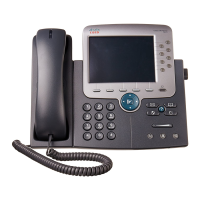E
Emily DayAug 31, 2025
What to do if the Settings button is unresponsive on my Cisco 7975G IP Phone?
- JJessica WadeAug 31, 2025
If the Settings button is unresponsive, your system administrator might have disabled it on your phone.








What to do if the Settings button is unresponsive on my Cisco 7975G IP Phone?
If the Settings button is unresponsive, your system administrator might have disabled it on your phone.
What does security error message mean on Cisco 7975G?
If you receive a Security Error Message on your Cisco IP Phone, your phone firmware has identified an internal error. If the message persists, contact your system administrator.
Why does Barge fail and result in a fast busy tone on my Cisco 7975G?
Barge fails and results in a fast busy tone because you cannot barge an encrypted call if the phone you are using is not configured for encryption.
What to do if Cisco 7975G cannot connect to TFTP server or to Cisco Unified Communications Manager?
If your Cisco IP Phone cannot connect to the TFTP server or Cisco Unified Communications Manager, make sure that the network is running. If you're using DNS to refer to the TFTP server or Cisco Unified Communications Manager, ensure that you've specified a DNS server.
What to do if Cisco Unified IP Phone cannot obtain IP address?
If a Cisco Unified IP Phone is unable to get an IP address, ensure that the network or VLAN it's connected to has access to the DHCP server. Also, verify that the switch port is enabled.
What to do if Cisco 7975G IP Phone does not register?
If your Cisco IP Phone isn't registering, the CTL file might not have the correct information for the Cisco Unified Communications Manager server. You should change the Cisco Unified Communications Manager server information in the CTL file.
What to do in case of configuration file corruption on Cisco IP Phone?
Create a new phone configuration file.
Why does my Cisco IP Phone screen appear blank?
If the screen on your Cisco IP Phone appears blank but the Display button is lit, the phone is powered down (sleeping) to save energy. The phone will power up (wake) when the system sends the wake up message. You cannot wake the phone before its scheduled power up time. To wake up the phone plug in the power adapter. Unplugging and plugging it back in will not wake up the phone while it is sleeping.
What to do if Cisco 7975G IP Phone cannot obtain a DHCP-assigned IP address after a factory reset?
If your Cisco IP Phone cannot obtain a DHCP-assigned IP address, and these errors typically indicate that the phone has completed a factory reset while 802.1X was enabled, then temporarily disable 802.1X authentication on the switch. Alternatively, temporarily move the phone to a network environment that is not using 802.1X authentication. Once the phone starts up normally in one of these conditions, you can access the 802.1X configuration menus and re-enter the shared secret.
What to do if Cisco Unified IP Phone resets unexpectedly?
If your Cisco Unified IP Phone is unexpectedly resetting, several factors could be at play. First, check the Ethernet connection to ensure it's active and that there are no cable breaks. It's also worth investigating whether intermittent network outages are affecting voice traffic. Make sure the phone is properly configured to use DHCP, or if a static IP address is assigned, verify the settings are correct. Isolating the phones on a separate auxiliary VLAN may also improve voice traffic quality. To see if the phone received a reset command from Cisco Unified Communications Manager, press the Applications Menu button, then go to Settings > Status > Network Statistics. Look for 'Reset-Reset' or 'Reset-Restart' messages.
| Handset type | Wired handset |
|---|---|
| Product type | IP Phone |
| Product color | Grey, Silver |
| Speakerphone | Yes |
| Voice codecs | G.711Mu, G.711a, G.722, G.729A, iLBC |
| Number of melodies | 24 |
| Aspect ratio | 4:3 |
| Display diagonal | 5.6 \ |
| Display resolution | 320 x 240 pixels |
| Lines quantity | 8 lines |
| Phonebook capacity | - entries |
| Number of VoIP accounts | - |
| Front camera | No |
| Security algorithms | 128-bit AES |
| Networking standards | IEEE 802.1Q, IEEE 802.1p, IEEE 802.1x, IEEE 802.3af |
| Ethernet LAN data rates | 10, 100, 1000 Mbit/s |
| Ethernet LAN interface type | Gigabit Ethernet |
| Supported network protocols | DHCP, TFTP |
| Volume control | Digital |
| Headphone outputs | 1 |
| Ethernet LAN (RJ-45) ports | 2 |
| Number of handles included | 1 pc(s) |
| AC adapter output voltage | 48 V |
| Storage temperature (T-T) | -10 - 60 °C |
| Operating temperature (T-T) | 0 - 40 °C |
| Operating relative humidity (H-H) | 10 - 95 % |
| Certification | FCC |
| Depth | 152.4 mm |
|---|---|
| Width | 266.7 mm |
| Height | 203.2 mm |
| Weight | 1600 g |
Details programmable buttons for access to lines, services, and call features, and the footstand for angle adjustment.
Explains the functions of display, messages, directories, help, settings, services, volume, speaker, mute, and headset buttons.
Covers navigation pads, keypad, softkey buttons, handset light strip, and the phone screen for user interaction.
Explains the primary phone line, programmable buttons, softkey labels, status line, call activity area, phone tab, and feature tabs on the phone screen.
